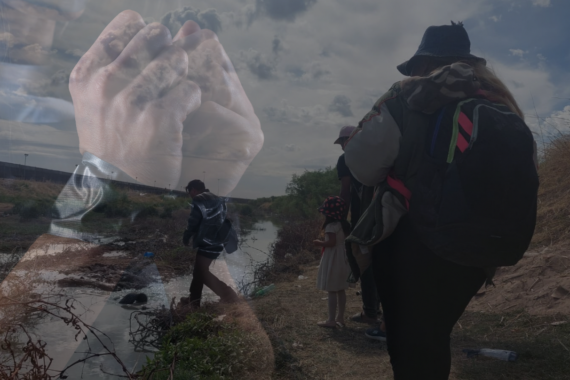Translated by Jesús Ronquillo / Circuito Frontera
It all happened in 4 minutes. The room filled with smoke and the flames were captured by security cameras until nothing could be seen.
Click here for the Spanish version
Today marks the one-year anniversary of the fire at the National Migration Institute (INM) in Ciudad Juarez, where 40 people died and 27 more were injured.
365 days after this event, neither the investigations have concluded nor the victims have received justice. This is how it all began.
In the course of 240 seconds, Provisional Stay B burned to the ground, claiming the lives of four dozen people.
Before that, a video shows how some migrants remove the mats where they were lying inside their cell and set it on fire.
The security guard leaves to ask for help, but despite the arrival of immigration agents, the place starts to catch fire. However, the cell doors are locked.
Below, the security cameras video from the National Migration Institute.
After several hours of the night and early morning, firefighters finally extinguished the fire.
In the morning, Federal Government authorities issued an official communiqué in which they reported the death of 39 people and 29 injured, all of whom were classified in a serious-delinquent state of health, and all of whom were men of legal age.
It is also indicated that as a result of the incident, a total of 68 people were taken into custody.

The fire was reported after 9:30 p.m. on Monday, March 27, 2023, inside the federal building, located between Lerdo and General Rivas Guillen streets, next to the “Lerdo” International Bridge, better known as “Santa Fe”.
Witnesses reported that the fire was started by migrants who were detained in the place, who were looking for a way to leave by force, since during the day they had been removed from the streets by means of raids led by INM personnel and supported by the National Guard.
The next day the hot atmosphere was still felt outside the migration station and the smell of ashes was penetrating, but even more so the pain of the friends and some relatives of the victims.
“And there Migration does nothing. They are seeing that they are burning. Ignorant people, open the door for them”- said Katiuska in desperation – “Because that is a fence, there is no escape from that. There are only two entrances here: that one and the exit, which I passed yesterday and saw,” said Katiuska, a woman of Venezuelan origin who arrived in Ciudad Juarez by train, along with her husband and children, “fighting” with other migrants.
She did not know it at the time, but later the authorities officially announced that the deceased migrants belonged to the following nationalities: one Colombian, one Ecuadorian, 12 Salvadorans, 28 Guatemalans, 13 Hondurans and 12 Venezuelans.
A provisional list of the dead and wounded was officially released after several visits to the city’s hospitals.
Three days after the incident, federal authorities informed that it would be the INM itself who would transfer the bodies to their place of origin.
While outside the INM, the days turned into hours of protests, indignation and sadness for the migrant community, who were also joined by border crossers.
Forty candles were marked as a stigma; each one with the name of one of the victims of the fire.
Some people brought a blue blanket and cans of white paint; the piece of cloth about five meters long was laid on the sidewalk, on which, with different calligraphies, the names of all the deceased were written.
Since then, the Provisional Stay B of the National Migration Institute in Ciudad Juarez was closed, and to date it continues to be out of operation, as well as 33 other stays throughout the Mexican Republic.
Weeks after the incident, the bodies of the victims began to be flown to El Salvador, Guatemala and Venezuela in a CASA 295 military plane.
Meanwhile, several camps began to conglomerate outside the federal immigration office and the Municipal Presidency, which over time grew to up to 33 camps.
There were also those who preferred to stay in inexpensive hotels in the downtown area, but also in houses and abandoned properties.
However, municipal authorities operated a campaign to evict them, as they considered that the safety of the migrants was in danger in those places.
These camps expanded rapidly, and even grew so much that they created a mini migrant city that increased 7.5 times in two weeks.
Activists even claimed that the intense mobility of migrants stationed in different parts of the city could have been between 15 and 20 thousand.
Despite the authorities’ efforts to move them to shelters, the migrants preferred to live on the streets rather than be locked up.
A mega tent was set up by municipal and federal authorities.
This place began operating on May 22, after hundreds of migrants were evicted, once again, from outside the Municipal Presidency facilities, where up to 150 makeshift homes were set up using tents.
The makeshift shelter was placed in the area of Los Hoyos de El Chamizal, a space located in a flood zone according to an IMTA document. However, it is still in place.
Official actions
On May 18, the INM requested the Ministry of Finance and Public Credit (SHCP) a “special” budget item for the reparation of damages, so that once the amount was defined by the Executive Commission for Attention to Victims (CEAV), the respective compensation would be carried out.
The National Human Rights Commission (CNDH) was informed of the temporary suspension of 33 temporary shelters of the INM, so that it could certify their conditions and determine which ones would be rehabilitated, which ones would be closed and which ones could continue operating.
139 days later, the same Federal Government issued a document specifying that the INM recognizes the death of 40 foreign migrants and the injuries suffered by 27 more, as a result of the fire caused by two persons of Venezuelan origin.
Recently, the National Migration Institute announced that to date 1,511 smoke detectors have been installed in migrant accommodation spaces and fire hydrants have been installed in nine facilities, as well as 23 seismic alerts.

The immediate removal of the metal protection grids from the medallions and sides of 424 transport vehicles used to transport foreign migrants in the country was ordered.
Likewise, the Lerdo-Stanton migratory station in Ciudad Juarez, Chihuahua, is under the custody of the Attorney General’s Office (FGR), as part of the investigation file derived from the fire that occurred on March 27, 2023.
Also, it was not until June 20, 2023 that the immigration authority implemented a comprehensive and progressive Civil Protection program for its housing spaces.
The omissions
The private security company “Grupo de Seguridad Privada CAMSA SA de CV” that operated in the National Institute of Migration (INM) incurred in at least nine omissions, announced Rosa Icela Rodríguez, Secretary of Citizen Security, stated this Friday in a third press conference on this issue.
“This contract will be repeated, reiteraoms the administrative sanctioning process was initiated against the company, which has already been notified, due to the fact that it incurred in at least nine omissions,” she said.
He said that there is a contract of the migratory institution with the security company that was granted by direct award and that allowed it to provide its services.
The company operated in 23 states of Mexico, and its contract established that it had a term from March 1 to December 31, 2023, with a minimum amount of 76 million pesos and a maximum of 190 million pesos.
The detainees
The officials who have been indicted in this case were: Francisco Garduño Yáñez; Antonio Molina Díaz; Salvador González Guerrero; Juan Carlos Meza Cumplido; Eduardo Apodaca Magallanes; Daniel Goray Yosioka; Rodolfo Collazo de la Torre, and Gloria Liliana Ramos García.
In addition to two migrants: Jaison N., and Carlos Eduardo C., both Venezuelan nationals.
A series of hearings for the indictment of the officials and the migrants were held for months, a situation that has not yet concluded.
Although in these hearings, several irregularities that occurred within the National Migration Institute were also revealed, even before the fire occurred.
During the initial hearing of the delegate of the National Migration Institute (INM), Francisco Garduño Yáñez, it was revealed by the Attorney General’s Office that through interviews with the survivors of the fire, the migrants captured and held in Provisional Stay B received offers from the officers, in exchange for the payment of one thousand dollars, to let them go “free”.
The witness identified as M.A.G.P. reported that “if they wanted to leave, they had to pay a thousand dollars”, in addition to harsh treatment by the guards who did not feed them. He also reported that one of the common phrases used against them was: “Nobody told them to come to Mexico,” in the face of mistreatment and humiliation.
Justice for Juan Carlos Meza
However, the law has been unfair not only to the victims and their families but also to several of those involved, especially to Juan Carlos Meza Cumplido, who was the coordinator of Grupo Beta and who, unlike the rest of the officials, his position did not implicate him as responsible.
Leonardo Lara Ferreiro, lawyer of Legal Estudio Jurídico and defender of Juan Carlos Meza, told Circuito Frontera that so far a financial guarantee of 2 million pesos has been set so that he can continue his legal process in freedom, an amount that his family has not yet gathered.
Also, the Control Judge accepted the imposition of an electronic bracelet, once this amount is collected.
It is important to remember that Juan Carlos Meza Cumplido is pointed out by the Attorney General’s Office as one of the alleged perpetrators, after presenting a document in which he is pointed out as the person in charge of the Internal Protection Unit, a document that lacks all the signatures of the intervening parties.
The lawyer of Legal Estudio Jurídico also pointed out that Juan Carlos Meza is not being held under the precautionary measure of justified pre-trial detention, nor is he being held on remand, but was left in a legal limbo without being able to continue his trial at liberty.

“The main reason why Juan Carlos is being detained is because the Prosecutor’s Office alleges that he was responsible for Civil Protection of the property. For this, they attach a constitutive act where they assign it to him, but we have alleged from the beginning that this document was not signed by Juan Carlos”, he explained.
The defense pointed out that the former coordinator of Grupo Beta cannot be held responsible for having caused harm to the migrants materially, since his detention is based on administrative and bureaucratic issues.
“Juan Carlos is detained for a designation that was not well done and for administrative irregularities. He is the only one they are holding on to, he is the basis of the Prosecutor’s claim, there is nothing else,” the lawyer affirmed

He also stated that Juan Carlos is not being held in preventive detention, either unofficial or justified, due to the fact that the Prosecutor’s Office could not justify a preventive detention either, although he is in a “legal limbo”.
“We already achieved, let’s say the legal part, which is the important thing that the judge reduced from 20 million to two million. That is one and the imposition of the electronic bracelet. Unlike the other detainees, they continue with the precautionary measure of preventive imprisonment, but Juan Carlos is now in a legal limbo because he is detained there due to lack of resources”, he said.










